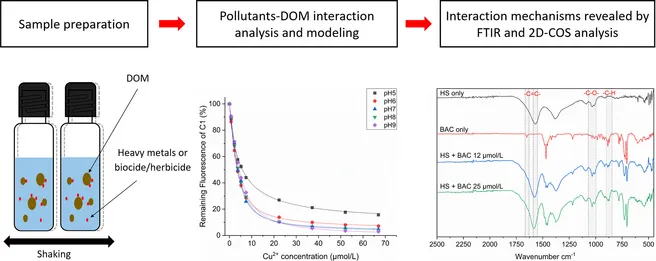Stormwater runoff from roofs and façades can be contaminated by heavy metals and biocides/herbicides. High efficiency on-site treatment methods are now urgently needed to safeguard the ecosystem. The basis for developing such treatment facilities is an in-depth understanding of their interactions with dissolved organic matter (DOM), as this affects their migration in the environment. Hence, the interactions between copper (Cu), zinc (Zn), benzyl-dimethyl-tetradecylammonium chloride dihydrate (BAC), mecoprop-P (MCPP) and DOM at pH 5 to 9 were investigated separately in this study. The evaluation of the interaction processes was achieved by applying excitation emission matrix and parallel factor analysis (EEM-PARAFAC) to titration samples; obtained data were fitted by two different models. Mechanisms involved in BAC/MCPP-DOM interactions were revealed by Fourier-transform infrared spectroscopy (FTIR) and two-dimensional correlation spectrum (2D-COS) analysis. Results showed that the applied DOM was composed of the two different fluorescent components C1 and C2. More interaction with C1 than with C2 was observed for both Cu/Zn and BAC/MCPP. Increasing the pH enhanced the interactions between Cu/Zn and DOM. At pH 5 with a maximum quencher addition, the remaining fluorescence of Cusingle bondC1 and Znsingle bondC1 were 15.7% and 87.1%, respectively. Corresponding data at pH 9 decreased to 3% and 69.5%. Contrarily, interactions between BAC/MCPP and DOM were impaired by high pH conditions. The increase of pH from 5 to 9 with maximum BAC and MCPP added raised the remaining fluorescence of BAC-C1 and MCPP-C1 by 15.9% and 21.3% separately. The fitting outcomes from the Ryan-Weber equation (Cu/Zn titration) and the Stern-Volmer equation (BAC/MCPP titration) corresponded well with the titration studies. FTIR coupled with 2D-COS analysis revealed that mechanisms involved in BAC/MCPP titration include hydrogen bonding, π-π interaction, and electrostatic effect. The order of mechanisms taking effect during the interaction with DOM is affected by the molecular structure of BAC and MCPP.
